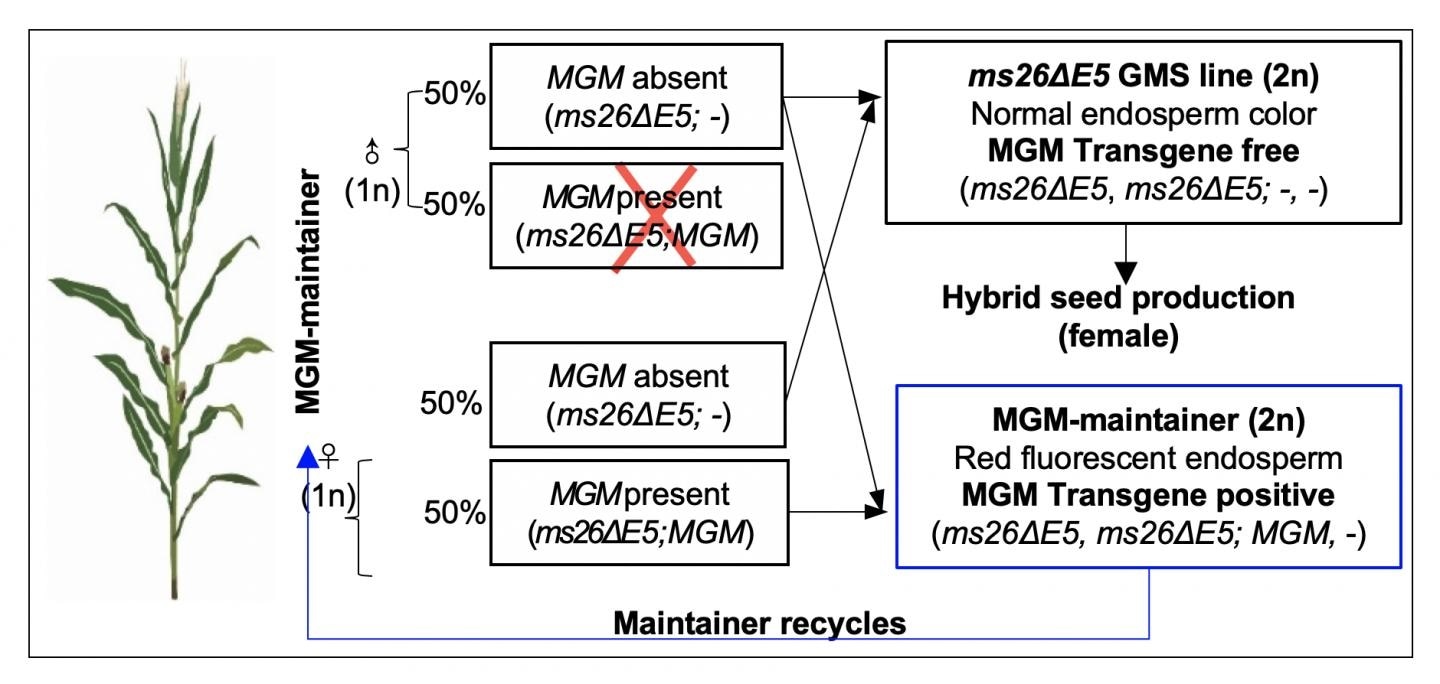Although crop hybrid technologies have played a key role in considerably improving crop yield across the world in the past decades, developing and maintaining a hybrid production line has invariably been laborious and complex.

This chart summarizes the workflow of the next-generation hybrid seed production in industrial practices. Image Credit: Chuanxiao Xie.
Chinese scientists have now designed a unique system integrating CRISPR-mediated genome editing with other methods that can potentially yield better seeds when compared to traditional hybrid techniques and reduce the production timeline by as much as 5 to 10 years. The study was published in the Molecular Plant journal on July 8th, 2020.
When it comes to crop production, hybrids are usually favored over purebreds. Crossing a pair of genetically distant plant varieties often results in progeny with better traits when compared to the parents. The offspring may have higher yields and improved tolerance to diseases. This kind of phenomenon is known as hybrid vigor, or heterosis.
But current hybrid methods are very time consuming and cumbersome.”
Chuanxiao Xie, Study Senior Author, Chinese Academy of Agricultural Sciences
For instance, the initial step to create a hybrid is to identify or create a type of parent plant that carries a mutation, so that it does not yield a viable pollen. This is done to prevent self-crossing and make sure that a majority of the parent plants are fertilized by another variety.
However, the progeny should be fertile to self-cross, so that it can produce more of itself and plants can also be utilized as the parent. The sterile plant would be crossed with another genetically fertile plant to restore the sterility of the plant and create hybrid seeds. Building such a production cycle is important for designing an efficient seed production line in the field.
Such methods have highly particular requirements of plants’ genotypes, and it can take years to establish fertile and infertile breeds.
These limitations have restricted them from being applied more widely in commercial agriculture. But our new system using CRISPR/Cas9 can significantly streamline the process. Now, one single transformation is enough.”
Chuanxiao Xie, Study Senior Author, Chinese Academy of Agricultural Sciences
Initially, Xie and his collaborators built a Cas9 vector that focuses on MS26—a fertility gene present in maize. The team also prepared another vector, known as MGM. The first vector functions by cutting out a part of the MS26 gene, which would render the plant genetically infertile. Three functional parts—an enzyme to inactive pollen, a working MS26 gene coding sequence to restore fertility, and a red color marker that would appear in seeds—are carried by the MGM vector.
The researchers introduced the two vectors into an agrobacterium and utilized it to convert maize embryos. Since maize is diploid—that is, it has a couple of copies of every gene—such edited embryos would carry a pair of copies of the mutated MS26 gene, besides a single copy of the MGM gene that was introduced by the team.
According to the rule of meiosis, when these plants self-cross, they create two types of offspring with a ratio of 1 to 1—one with the mutated MGM and MS26 genes, and one with the mutated MS26 but lacking the MGM gene.
The progeny lacking the MGM gene is infertile, and hence it can be employed as a parent for the production of hybrid seeds. Since the exogenous MGM gene is not carried by these parents, their offspring—if crossed with a non-genetically engineered variety—are not transgenic.
The remaining 50% of the offspring carrying the MGM and MGM-present offspring is fertile, and remain the same as their parents. Such plants—known as the maintainers—can be self-crossed to create plants that are more infertile and to produce hybrids as well as more maintainers.
In addition, the maintainers carry a red fluorescent marker that is expressed from the MGM vector, and hence they can be easily classified and distinguished from the sterile seeds.
Our system significantly reduces the resources needed to construct stable hybrid seed production lines. So the inputs and costs of seeds would be much lower.”
Chuanxiao Xie, Study Senior Author, Chinese Academy of Agricultural Sciences
In addition to maize, several other important crops also have the MS26 gene, such as millet, rice, sorghum, and wheat. Hence, the latest method can be readily used on other crops and also on other fertility-determining genes in crops, Xie added.
“Technology-wise, we are not far from large-scale applications. But there is a procedure we need to go through before getting approved for commercial production,” Xie concluded.
Source:
Journal reference:
Qi, X., et al. (2020) Genome Editing Enables Next-Generation Hybrid Seed Production Technology. Molecular Plant. doi.org/10.1016/j.molp.2020.06.003.